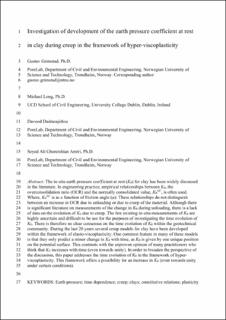Investigation of Development of the Earth Pressure Coefficient at Rest in Clay During Creep in the Framework of Hyper-Viscoplasticity
Peer reviewed, Journal article
Accepted version

Åpne
Permanent lenke
https://hdl.handle.net/11250/2726082Utgivelsesdato
2021Metadata
Vis full innførselSamlinger
Originalversjon
10.1061/(ASCE)GM.1943-5622.0001883Sammendrag
The in situ earth pressure coefficient at rest (K0) for clay has been widely discussed in the literature. In engineering practice, the empirical relationships between K0, the overconsolidation ratio (OCR), and the normally consolidated value (KNC0), is often used. Where KNC0 is as a function of friction angle (φ). These relationships do not distinguish between an increase in OCR that is due to unloading or the creep of the material. Although there is a significant amount of literature on the measurement of the change in K0 during unloading, there is a lack of data on the evolution of K0 due to creep. The few existing in situ measurements of K0 are highly uncertain and are difficult to use to investigate the time evolution of K0. Therefore, there is no clear consensus on the time evolution of K0 within the geotechnical community. Over the last 20 years, several creep models for clay have been developed within the framework of elastoviscoplasticity. One common feature of many of these models is that they only predict a minor change in K0 with time, because K0 is given by one unique position on the potential surface. This contrasts with the unproven opinion of many practitioners who think that K0 increases with time (even toward unity). To broaden the perspective of the discussion, this paper addresses the time evolution of K0 in the framework of hyper-viscoplasticity. This framework offers a possibility for an increase in K0 (even toward unity under certain conditions).